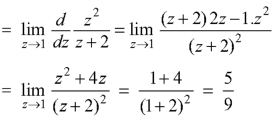Question Bank
Module–4
Functions of complex variable
Question-1: Find-

Sol. Here we have-

Divide numerator and denominator by  , we get-
, we get-

Question-2: If w = log z, then find  . Also determine where w is non-analytic.
. Also determine where w is non-analytic.
Sol. Here we have 
Therefore-


And 
Again-


Hence the C-R conditions are satisfied also the partial derivatives are continuous except at (0 , 0).
So that w is analytic everywhere but not at z = 0

Question-3: Prove that the function  is an analytical function.
is an analytical function.
Sol. Let  =u+iv
=u+iv
Let  =u and
=u and  =v
=v



Hence C-R-Equation satisfied.
Question-4: Prove that 
Sol. Given that



Since 

V=2xy

Now 






But 



Hence 
Question-5: Check whether the function w = sin z is analytic or not.
Sol. Here-


Now-

And


Here we see that C-R conditions are satisfied and partial derivatives are continuous.
Question-6: Evaluate  along the path y = x.
along the path y = x.
Sol.
Along the line y = x,
Dy = dx that dz = dx + idy
Dz = dx + i dx = (1 + i) dx

On putting y = x and dz = (1 + i)dx



Question-7:Evaluate  where C is |z + 3i| = 2
where C is |z + 3i| = 2
Sol.
Here we have-

Hence the poles of f(z),

Note- put determine equal to zero to find the poles.

Here pole z = -3i lies in the given circle C.
So that-



Question-8: Solve the following by cauchy’s integral method:

Solution:
Given,


= 
= 
= 
Question-9: Evaluate the integral given below by using Cauchy’s integral formula-

Sol. Here we have-

Find its poles by equating denominator equals to zero.

We get-

There are two poles in the circle-
Z = 0 and z = 1
So that-


Question-10: Find the singularity of 
Sol.
Here we have-

We find the poles by putting the denominator equals to zero.
That means-




Question-11: Find the poles of the following functions and residue at each pole:
 and hence evaluate-
and hence evaluate-
 where c: |z| = 3.
where c: |z| = 3.
Sol.

The poles of the function are-

The pole at z = 1 is of second order and the pole at z = -2 is simple-
Residue of f(z) (at z = 1)


Residue of f(z) ( at z = -2)


Question-12: Evaluate-

Where C is the circle |z| = 4.
Sol.
Here we have,

Poles are given by-



Out of these, the poles z = -πi , 0 and πi lie inside the circle |z| = 4.
The given function 1/sinh z is of the form 
Its poles at z = a is 
Residue (at z = -πi)

Residue (at z = 0)

Residue (at z = πi)

Hence the required integral is = 
Question-13: Evaluate  where c;|z|=4
where c;|z|=4
Sol.
Here f(z)=
Poles are 
Sin iz=0

Poles 
Lie inside the circle |z|=4
The given function  is of the form
is of the form 
Its pole at z=a is 
Residue (at 


Residue at z=0=
Residue at  =
=

Residue at  are
are
Respectively -1,1 and -1
Hence the required integrand

Question-14: Evaluation of definite integrand
Show that 
Sol.
I= 
Real part of 
Now I=  =
=
Putting z= where c is the unit circle |z|=1
where c is the unit circle |z|=1
I=

Now f(z) has simple poles at  and z=-2 of which only
and z=-2 of which only  lies inside c.
lies inside c.
Residue at  is
is 
=
 =
=
Now equating real parts on both sides we get
I=
- Prove that

Solution Let 



Putting  where c is the unit circle |z|=1
where c is the unit circle |z|=1

2ai
Poles of f(z) are given by the roots of

Or 

Let 
Clearly  and since
and since  we have
we have  Hence the only pole inside c is at z=
Hence the only pole inside c is at z=
Residue (at  )
)




Question-15: Prove that 
Sol.
Consider 
Where c is the contour consisting of a large semicircle in the upper half plane indented at the origin as shown in the figure
Here we have avoided the branch point o, of  by indenting the origin
by indenting the origin
Then only simple of f(z) within c is at z=i
The residue(at z=i) =

Hence by residue theorem

Since  on -ve real axis.
on -ve real axis.

Now 

Similarly 

Hence when 


Equating real parts we get


Question-16: Solve the following by cauchy’s integral method:

Solution:
Given,


= 
= 
= 